

Sitting atop their food chain and accumulating in their bodies any persistent pollutants affecting prey species, raptors are indicators of problems in the environment. Indeed, although American kestrels are in a population nosedive, perhaps because of declines in their farmland habitat, raptors are doing quite well overall. Last year, Cape May set a record: 467 bald eagles during the season's count. Now, the counts are showing their comeback. Up to 400 people will be on the deck, binoculars swinging skyward in unison when someone shouts out a good sighting.Įrnesto Ruelas, the group's raptor index population manager, said that, though some counts have been operating 75 years, most groups standardized their protocols a few decades ago.īy now, the wealth of data is leading to breakthroughs in understanding migration patterns.Īuthor Rachel Carson used migration data from Hawk Mountain to support her assertion that bald eagles were in a serious decline. On a good day, maybe 2,000 raptors will pass overhead from as far north as Greenland, typically hugging the coast on the way south. The results were no surprise to the regulars who every late summer and fall head for Cape May to hang out at a large deck overlooking a wooded area, a freshwater pond, some dunes, a World War II ruin, and the open water beyond - where the Atlantic Ocean and Delaware Bay meet. That's the assessment of more than 2,000 readers of Birder's World, one of the nation's top birding magazines. It was the first day of the annual hawk watch at the best place in North America to see the fall migration: Cape May Point State Park.

They watched it for a while, then looked at each other and smiled. Wednesday, when the air was still cool and the sun was just a glow on the horizon, Melissa Roach and Pete Dunne saw it through their binoculars, riding in low over the cedars: an American kestrel, also known as a sparrow hawk.


 0 kommentar(er)
0 kommentar(er)
